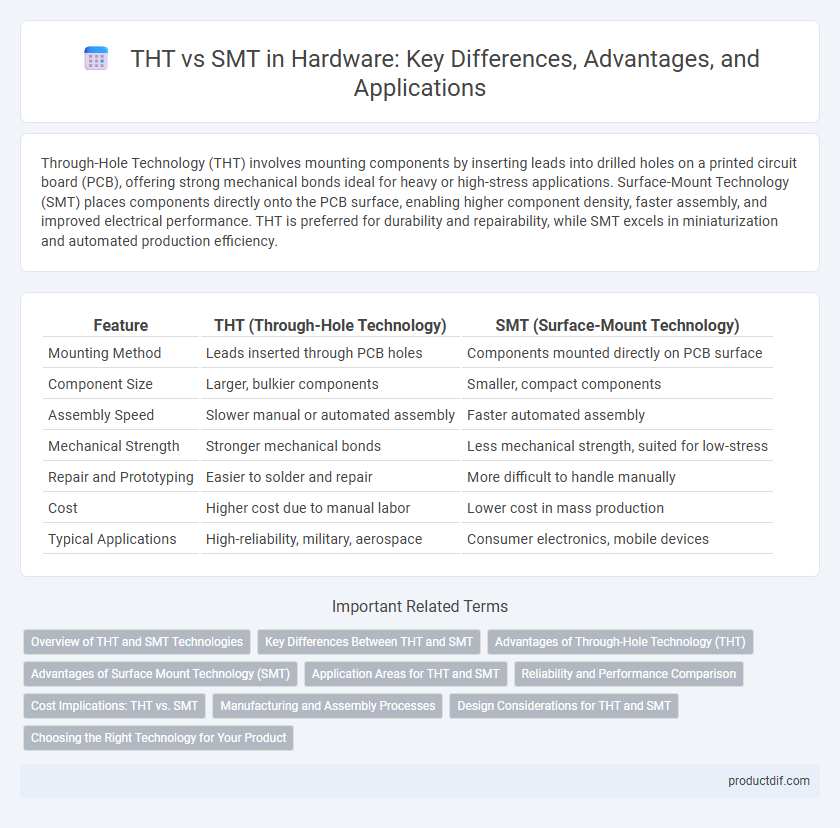Through-Hole Technology (THT) involves mounting components by inserting leads into drilled holes on a printed circuit board (PCB), offering strong mechanical bonds ideal for heavy or high-stress applications. Surface-Mount Technology (SMT) places components directly onto the PCB surface, enabling higher component density, faster assembly, and improved electrical performance. THT is preferred for durability and repairability, while SMT excels in miniaturization and automated production efficiency.
Table of Comparison
| Feature | THT (Through-Hole Technology) | SMT (Surface-Mount Technology) |
|---|---|---|
| Mounting Method | Leads inserted through PCB holes | Components mounted directly on PCB surface |
| Component Size | Larger, bulkier components | Smaller, compact components |
| Assembly Speed | Slower manual or automated assembly | Faster automated assembly |
| Mechanical Strength | Stronger mechanical bonds | Less mechanical strength, suited for low-stress |
| Repair and Prototyping | Easier to solder and repair | More difficult to handle manually |
| Cost | Higher cost due to manual labor | Lower cost in mass production |
| Typical Applications | High-reliability, military, aerospace | Consumer electronics, mobile devices |
Overview of THT and SMT Technologies
Through-Hole Technology (THT) involves mounting electronic components by inserting leads into drilled holes on a printed circuit board (PCB) and soldering them on the opposite side, providing strong mechanical bonds ideal for heavy or high-stress parts. Surface-Mount Technology (SMT) places components directly onto the PCB surface with solder paste and reflow soldering, enabling higher component density, smaller board sizes, and automated assembly processes. SMT offers improved electrical performance and cost efficiency compared to THT, which is often used for components requiring enhanced durability or high power handling.
Key Differences Between THT and SMT
Through-Hole Technology (THT) involves inserting component leads into drilled holes on a printed circuit board (PCB) and soldering them on the opposite side, providing strong mechanical bonds ideal for heavy or high-stress components. Surface Mount Technology (SMT) mounts components directly onto the PCB surface, allowing for higher component density and faster automated assembly due to smaller, leadless components. THT is preferred for durability and testing ease, while SMT excels in miniaturization and mass production efficiency.
Advantages of Through-Hole Technology (THT)
Through-Hole Technology (THT) offers superior mechanical strength and durability, making it ideal for components subjected to high stress or mechanical wear. THT components provide better heat dissipation and enhanced reliability in high-power applications compared to Surface-Mount Technology (SMT). The larger hole size in THT boards simplifies manual assembly and prototyping, facilitating easier inspection and rework processes.
Advantages of Surface Mount Technology (SMT)
Surface Mount Technology (SMT) offers significant advantages over Through-Hole Technology (THT), including higher component density and smaller PCB size due to the ability to mount components on both sides of the board. SMT enables faster automated assembly processes, reducing production time and costs while improving consistency and reliability in soldering. The enhanced electrical performance of SMT components, caused by shorter lead lengths, results in better signal integrity and reduced parasitic inductance.
Application Areas for THT and SMT
Through-Hole Technology (THT) is predominantly applied in industries requiring high mechanical stability, such as aerospace, automotive, and military electronics, where components must withstand extreme conditions and vibrations. Surface-Mount Technology (SMT) dominates consumer electronics, telecommunications, and medical devices due to its suitability for high-density, compact circuit designs and automated mass production. THT components are favored for connectors, large transformers, and capacitors, while SMT is preferred for fine-pitch ICs, resistors, and capacitors in miniaturized PCBs.
Reliability and Performance Comparison
Through-hole technology (THT) offers superior mechanical strength and reliability in high-stress environments due to its robust solder joints penetrating the PCB, making it ideal for heavy components and power applications. Surface-mount technology (SMT) excels in performance by enabling higher component density and faster signal transmission with shorter lead lengths, which significantly reduces parasitic inductance and capacitance. While SMT provides better electrical performance and miniaturization, THT maintains an edge in durability and thermal cycling resilience for critical, high-reliability applications.
Cost Implications: THT vs. SMT
Through-hole technology (THT) generally incurs higher manufacturing costs due to increased labor and material usage, including more extensive drilling and manual soldering processes. Surface-mount technology (SMT) reduces assembly expenses by enabling automated placement and soldering, resulting in faster production cycles and less material consumption. While SMT offers cost efficiency for high-volume production, THT remains cost-effective for small batches or prototypes requiring durability and mechanical strength.
Manufacturing and Assembly Processes
Through-Hole Technology (THT) involves inserting component leads through pre-drilled holes on a printed circuit board (PCB) and soldering them on the opposite side, requiring manual or selective automated insertion and wave soldering, which is labor-intensive and time-consuming. Surface-Mount Technology (SMT) allows components to be placed directly onto the PCB surface using automated pick-and-place machines followed by reflow soldering, enhancing speed, precision, and scalability in manufacturing. SMT offers higher component density and reduced assembly costs, making it the preferred choice for modern mass production, while THT is often reserved for components needing mechanical strength or high power dissipation.
Design Considerations for THT and SMT
Through-hole technology (THT) design emphasizes robust mechanical connections and is preferred for components requiring high mechanical stress tolerance or heat dissipation. Surface-mount technology (SMT) design prioritizes compact layouts and higher component density, enabling smaller, lighter, and more complex circuit boards. Thermal management and ease of automated assembly are critical factors influencing the choice between THT and SMT in electronic hardware design.
Choosing the Right Technology for Your Product
Through-Hole Technology (THT) offers superior mechanical strength and is ideal for products exposed to high stress or heavy components, while Surface Mount Technology (SMT) enables higher component density and automated assembly, reducing production costs. Selecting the appropriate technology depends on factors such as product durability requirements, size constraints, and production volume, with SMT favored for compact, high-volume electronics and THT preferred for robust, heavy-duty applications. Evaluating these criteria ensures optimal performance, manufacturability, and cost-efficiency in your hardware design.
THT vs SMT Infographic

 productdif.com
productdif.com